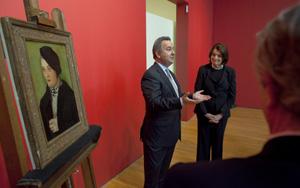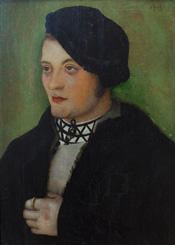A family’s six-decade search for a rare Renaissance painting comes to a happy conclusion

In spring 1943, Freidrich and Louise Gutmann, a Jewish couple from a prominent banking family, were bargaining for their lives. They negotiated with the Nazis to ship seven paintings from their renowned collection in exchange for safe passage from the Netherlands to Italy. The Gutmanns never made it: They died in concentration camps – Fritz in Theresienstadt, Louise in Auschwitz.
Earlier this week, the Zimmerli Art Museum at Rutgers returned one of the original paintings the Gutmanns had shipped, a rare early 16th-century portrait, to the couple’s grandson, Simon Goodman. The portrait is by German artist Hans Baldung Grien, considered the most gifted of the followers of Albrecht Dürer.'
“The restitution of this painting is a vindication for my family,” said Goodman, who accepted the portrait January 14 at Rutgers on behalf of his brother, Nick, and his 91-year-old aunt, Lili Gutmann, who lives in Florence, Italy. After many years of protracted dealings with art world institutions, he said, “I can’t get over the civility, kindness, and sympathy we’ve received from individuals at Rutgers and the Zimmerli.”
"On behalf of the university, we are enormously proud to be able to make this right," said Philip Furmanski, executive vice president for academic affairs at Rutgers.
The family had been looking for the painting for more than 50 years. Simon’s father Bernard Gutmann (who settled in England and anglicized his name to Goodman), and his aunt Lili, dedicated their lives to researching and reclaiming the artwork in their parents’ 18th-century estate, which consisted of about 60 old masters, including works by Bosch and Botticelli, and as well as impressionist works by Degas and Renoir. When Bernard died in 1994, he and his sister had successfully reclaimed or bought back about a third of the collection. But the Hans Baldung Grien eluded them.
After their father’s death, Simon, and, Nick, both of Los Angeles, continued to search for artworks and objects looted by the Nazis. Last year, flipping through a rare catalogue of the artist by a German art historian in the Getty library, Simon spotted the Hans Baldung Grien. The painting, which had made its way to dealers in New York after the war, was donated to Rutgers in 1959 by Rudolf Heinemann, an international art dealer and collector who died in 1975.

From the moment Simon Goodman contacted the Zimmerli about the painting, museum director Suzanne Delehanty said the university took the family’s claim most seriously.
“The restitution of World War II artwork is one of the most important legal and moral issues facing museums today,” Delehanty said. “We spent nearly a year researching the case.”
Rutgers associate general counsel Elizabeth Minott examined museum records and the family’s documentation, which included letters from the international governments and the German art dealer who sold the painting to the Nazis. The university was assisted by guidelines from the Association of Art Museum Directors, which has developed protocols to help museums resolve cases related to Nazi-looted art.
“The project was fascinating, and it has been so very satisfying to give the painting back to a family who has suffered so unjustly,” Minott said.
According to scholars, approximately 20 percent of Europe’s treasures were looted by the Nazis for a museum Hitler envisioned in his hometown of Linz, Austria. More than 100,000 items – including paintings, sculpture, crystal, silver, and china – have not been returned to their rightful owners.
The Goodman family has been a leader in changing policies on the restitution of looted art. In 1998 a case involving a Degas landscape from the Gutmann collection helped prompt a conference involving 44 nations to adopt principles for resolving issues of Nazi-confiscated art.
“On behalf of the university, we are enormously proud to be able to make this right,” said Philip Furmanski, executive vice president for academic affairs at Rutgers, at the hand-over ceremony. While the restitution can never make up for the humanity that was lost during World War II, he said, “it keeps in the public view what a horror this has been – and it is still not completely adjudicated.”
Goodman said he plans to sell the painting at Christie’s New York auction at the end of the month in order to divide the proceeds among the heirs. The painting, believed to be a self-portrait of the artist, is expected to fetch $200,000 to $300,000.